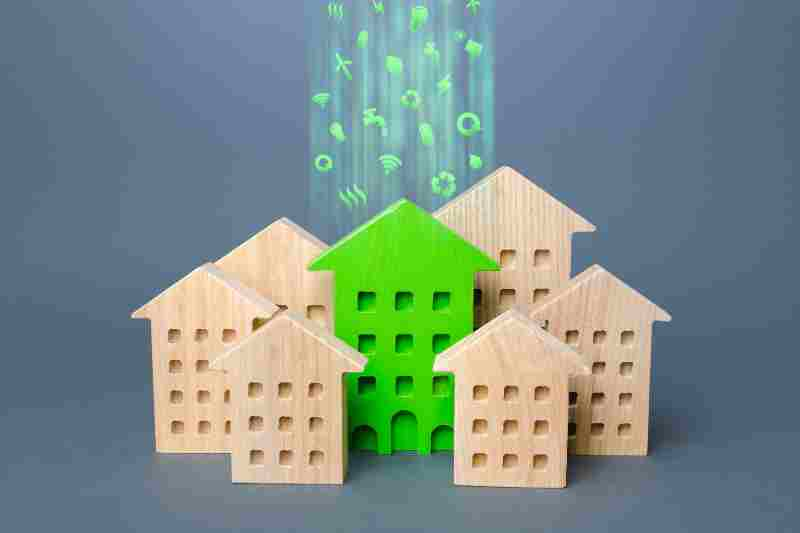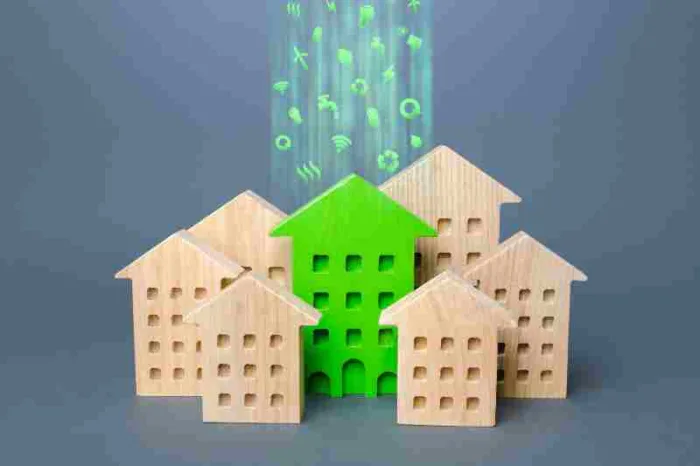Key takeaways
- Striving for net zero in real estate is a major step toward sustainable living and building construction.
- For a building to be considered net zero, it must have renewable energy sources, have onsite energy generation, and run efficiently.
- To achieve net zero in real estate, investors and buildings should install energy monitors, use energy-efficient windows, install renewable energy sources, and invest in smart building technology.

A global effort to reduce collective carbon outputs has been in effect for decades. Moreover, everyone is committed to doing their part to make Earth a better place to live with more sustainable buildings. But did you also know these efforts can extend to the real estate industry?
Below, discover what net zero real estate is, what it means for your building, and how to achieve it.
In this post, we cover:
- What is net zero in real estate?
- What does it mean for a building to be net zero?
- How do you make a property net zero carbon?
What is net zero in real estate?
Net zero in real estate is the desired carbon emissions reduction goal within the real estate sector.
Many world governments and agencies are committing to a net zero carbon emission plan. And real estate professionals are asked to do the same. In order to help meet this significant goal, real estate professionals should aim to achieve carbon neutrality by 2030.
As it stands, real estate carbon emissions make up 40 percent of carbon emission rates globally. These emissions are primarily generated by construction and general operations. So, new construction is a major contributor to carbon emissions.
Carbon neutral vs. net zero
You’ve probably heard the term carbon neutral come up in your research of net zero real estate. So, what’s the difference?
Here’s the difference between carbon neutral and net zero:
- Carbon neutral. Carbon neutral architecture means that your real estate building is balanced in its carbon emissions. Meaning it’s not overproducing, nor is it actively being curbed.
- Net zero. Net zero specifically means your real estate venture has never produced carbon emissions from the beginning.
This distinction is very important because it helps create a framework for future projects and marketing for real estate properties. While transforming your building to a carbon-neutral one helps reduce overall emissions, approaching your real estate project as net zero from the start eliminates carbon emissions entirely.
What does it mean for a building to be net zero?
A net zero building is one with net zero energy consumption. In other words, a net zero building creates the same amount of renewable energy onsite as it uses.
For a building to be considered net zero, it must:
- Run efficiently and optimally.
- Have onsite energy generation.
- Use renewable resources.
The bottom line is that a net zero property will need very little energy input from standalone sources. By planning environmental factors such as shading, water supply, and local vegetation, constructing net zero architecture is attainable.
How do you make a property net zero carbon?
Studies show that in response to climate protection efforts, properties with higher emission output are less desirable. Put simply, lower-emitting buildings are likely to attract more investors and make more revenue than their higher-emitting counterparts.
So, here are four ways to help the real estate industry achieve net zero carbon:
- Install energy monitors
- Use energy-efficient windows
- Install renewable energy sources
- Invest in smart building technology
1. Install energy monitors
Energy monitors are devices that monitor the energy needed to run a building efficiently. As a result, you create an energy efficient office, apartment, or industrial site.
The energy monitor will record the electricity use within your building and create a report. With this report, you can easily find the highest energy-using appliances and reduce your use.
There are three types of energy monitoring systems from which to choose:
- Online monitors. With an online monitor, you install the system within your building and then use the app on your phone to view the report.
- Handheld monitors. When using a handheld monitor, you attach a sensor from the handheld device and read the energy report from the screen.
- Plug-in monitors. With a plug-in monitor, you have to plug it into the wall. Then, plug each appliance into the device as it reads each energy signature.
Moreover, energy monitors can only read electrical appliances. So, they’re of no use to solar or gas-powered units.
2. Use energy-efficient windows
Energy-efficient windows are designed to help block out cold and hot air. This can greatly cut down on what it takes to heat or cool a building against outdoor elements.
As a result of using energy-efficient windows, HVAC systems may even last longer. Furthermore, you’ll experience a more consistent temperature within your building. All these building decarbonization factors greatly contribute to less energy usage and are instrumental steps to achieving net zero carbon emissions.
Learn more about sustainable building:
3. Install renewable energy sources
One of the best examples of renewable energy is solar power. Solar power is not only a popular method of renewable energy, but it’s also one of the simplest in terms of installation and widespread use.
Other renewable energy sources that can help make a property net zero of carbon neutral include:
- Electric vehicle charging stations
- Battery energy storage
- Backup batteries
4. Invest in smart building technology
Smart building technology can reduce carbon footprint in real estate by:
- Retrofitting. Retrofitting smart technology, such as smart intercoms, HVAC, and more, is a great way to make use of what’s already available. Reusing existing structures eliminates new energy waste. Furthermore, by retrofitting, you can help make older buildings more energy compliant.
- Monitoring. Many smart building technologies will monitor energy use throughout the building. This is especially true of smart HVAC systems and renewable energy systems such as solar and wind.
- Controlling. With the right smart technology, self-control is a major bonus. HVAC, power, and battery systems are designed to shut themselves on and off depending on energy needs. This is a great step toward energy efficiency because it relies more on real-time data to make energy-saving decisions.







